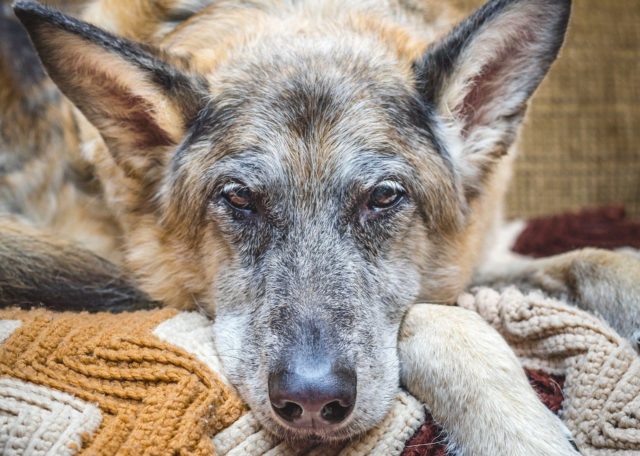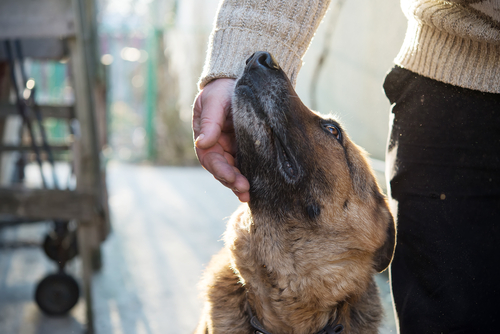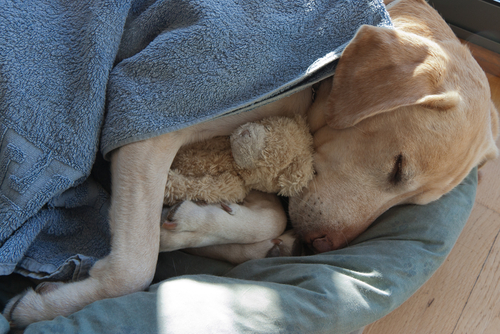Hospice care for dogs is a relatively new concept. Sadly, the word hospice often carries a negative stigma. It reminds us of lonely, sterile rooms and the fear of impending death. In reality, hospice care can be a wonderful gift for terminally ill people and pets. Rather than focusing on invasive medical procedures, hospice provides physical and emotional comfort to end-of-life patients and their families.

What is hospice care for dogs?
Hospice care is based on the philosophy that people and pets deserve to die with dignity. When a dog is suffering from a serious illness and a cure is not possible, hospice care provides a temporary alternative to euthanasia. The goal is to make their remaining days comfortable with pain medications, dietary strategies and human interaction.
Dr. Alice Villalobos is a world-renowned veterinary oncologist. She coined the term “pawspice,” which she describes as supportive care in evaluating and managing quality of life in the time leading up to a pet’s death.
“In-home ‘pawspice’ care is a wonderful next step,” Dr. Villalobos says. “It should be introduced as an interval between the thought and the final act of euthanasia, if the owner really feels that their pet still has a quality of life.”
Hospice care for dogs also allows families to come to terms with the impending loss of a beloved friend. In keeping a terminal pet comfortable, the human family members have time to come to terms with the situation. Hospice allows them to plan special moments with their dog, take family photos, and seek emotional and spiritual support.
What does hospice care for dogs involve?
According to the American Veterinary Medical Association (AVMA):
“A pet hospice service typically includes on-call availability of the veterinarian to provide urgent care as needed; extended appointments including counseling and support for decision-making; in-home care; medications and other therapies administered to relieve discomfort, stress and pain; euthanasia options tailored to your and your pet’s needs (which may include in-home euthanasia); and pet loss support/grief counseling.”
Depending on each patient’s individual needs, hospice care for dogs may include simple guidance or formal in-home services by trained veterinary staff. In-home caregivers may provide medications, supplements, fluid therapy, massage, and/or acupuncture to ensure your dog stays comfortable and pain-free. If hospice staff are not available, your veterinarian may teach you how to administer treatments yourself.

How do you know when it is time to say goodbye?
Dr. Villalobos created a Quality of Life Scale to help veterinarians and pet caregivers determine how successful pawspice care is for a particular dog or cat. Also known as The HHHHHMM Scale, it asks caregivers to assign pets a score from 0 – 10 in the categories Hurt, Hunger, Hydration, Hygiene, Happiness, Mobility, and More Good Days Than Bad.
The higher the score, the better the animal’s quality of life. However, the quality of a dog’s life should include their overall physical and mental well-being, not just one or two aspects. If your dog scores highly in Hydration and Hunger, but low in Hurt and Mobility, it may be time to discuss euthanasia with your vet.
You may also wish to make a list of three to five of your dog’s favorite things to do. When he or she is no longer able to enjoy these activities, it may be time to say goodbye.

More ways to comfort a hopice dog
In addition to the items on the Quality of Life Scale, hospice dogs still have many of the same wants and needs as before. It is important to maintain old routines and provide familiar comforts when possible. Remember to:
- Surround your dog with his or her favorite things, like warm blankets and special toys.
- Provide a high-quality orthopedic bed to prevent pressure sores in dogs with limited mobility.
- Brush, bathe, and spot-clean your dog as needed. Incontinence and limited mobility can lead to a messy, matted coat. This is embarrassing and uncomfortable. If your dog is unable to go outside with assistance or comfortably endure a bath, use a pet-specific dry shampoo to keep his or her coat clean, smooth and dry.
- Most importantly, spend time with your dog outside of your care-giving tasks. If your dog can no longer climb stairs or hop on furniture, make a cozy spot next to him or her on the floor. Read or watch TV, share a special treat, or simply snuggle. Your presence means more to your dog than anything else.
Coping with the loss of your dog
Unfortunately, hospice care for dogs always ends the same: with the loss of your furry friend. While everyone grieves differently, you may find comfort from the following sources:
- Form a support network and don’t be afraid to discuss your feelings.
- Gather family and friends to memorialize your pet.
- Encourage children to write letters, draw pictures, or plant a tree in your dog’s honor.
- Take time to grieve. Remember, there is no set amount of time for you to “get over it.”
- If you experience symptoms of depression, consult your doctor.
- Remember your dog loves you and wants you to be happy.
H/T to PetMD, ASPCA & Whole Dog Journal


 Toledo, United States.
Toledo, United States.
